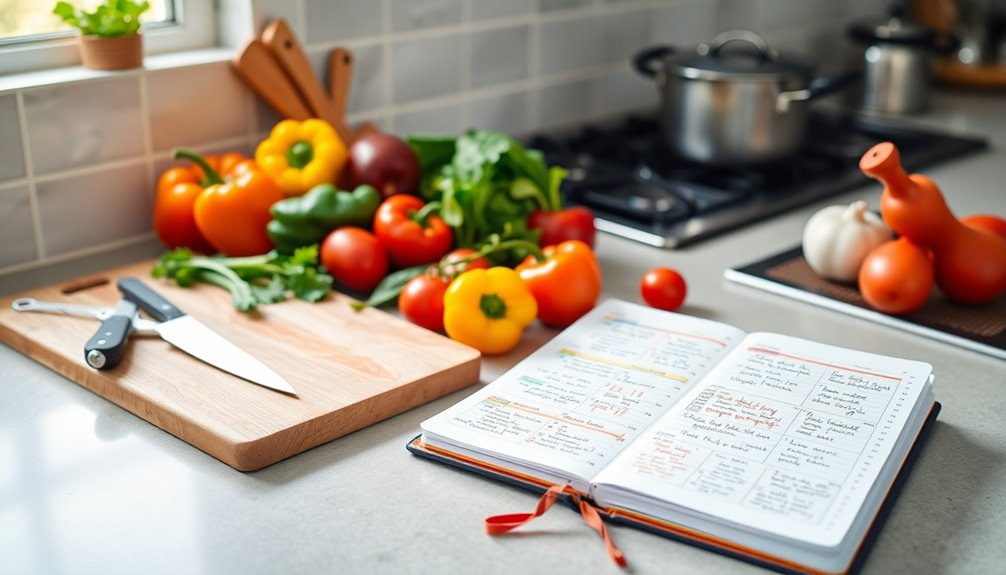To create a foolproof meal plan, begin by evaluating your dietary requirements, concentrating on age, physical activity, and health considerations. Next, select recipes that align with these criteria, guaranteeing a variety of flavors. Then, compile a shopping list categorized by store aisles and inspect your pantry for unused ingredients. Schedule regular meal prep sessions to cook in batches and portion out meals efficiently. Lastly, remain adaptable; modify your plan as necessary and embrace leftovers to minimize waste. This methodical approach not only improves your nutrition but also simplifies your cooking routine, and there's much more to discover about optimizing your meal planning strategy.
Key Takeaways
- Assess your dietary needs by considering age, gender, activity level, and health concerns to determine caloric and macronutrient requirements.
- Choose recipes that align with your dietary needs, ensuring a variety of flavors and cooking techniques to keep meals interesting.
- Create a shopping list that includes budget-friendly ingredients, organized by store sections, while checking your pantry for what you already have.
- Schedule dedicated time for meal prep, gathering all ingredients and tools, and portioning meals into labeled containers for easy access.
- Stay flexible and ready to adjust your meal plan as needed, incorporating leftovers and maintaining variety to support overall health.
Assess Your Dietary Needs

Evaluating your dietary requirements is the cornerstone of creating a successful meal plan. Understanding what your body needs ensures you maintain nutritional balance, which is essential for overall health and well-being. Start by appraising your age, gender, activity level, and any specific health concerns. These factors influence your caloric and macronutrient needs, helping you tailor your meal plan effectively.
Next, focus on nutritional balance. Aim for a variety of food groups, including fruits, vegetables, whole grains, lean proteins, and healthy fats. This variety not only provides essential vitamins and minerals but also keeps your meals interesting and satisfying. Consider consulting resources or a registered dietitian to help you identify the right balance for your unique situation. Additionally, utilizing a custom keto diet plan can provide tailored meal suggestions aligned with your specific dietary needs.
Portion control is another critical aspect of evaluating your dietary requirements. It's easy to overlook serving sizes, especially when enjoying delicious meals. By familiarizing yourself with standard portion sizes, you can avoid overeating while still enjoying your favorite foods. Using measuring tools or visual cues, like comparing portions to everyday objects, can help reinforce these concepts in your daily routine.
Lastly, keep in mind that meal planning isn't just about restriction; it's about nourishing your body and fostering a sense of community around food. By evaluating your dietary requirements, you're laying the groundwork for a meal plan that supports your health and brings joy to your dining experiences. Embrace this process, and you'll create a meal plan that works for you and your lifestyle.
Choose Your Recipes

With a clear understanding of your dietary needs, it's time to choose recipes that align with your goals and preferences. Start by exploring diverse recipe selections that cater to your specific requirements. Whether you're looking for low-carb, vegetarian, or high-protein meals, focus on incorporating ingredients that not only meet your nutritional needs but also excite your palate.
Think about the flavor profiles of the dishes you select. Mixing and matching flavors can elevate your meals from ordinary to extraordinary. For instance, if you love bold, spicy flavors, look for recipes featuring ingredients like chili, garlic, or ginger. If you prefer something milder, opt for dishes that highlight herbs like basil or parsley. This strategy not only keeps your meals interesting but also helps you stay committed to your meal plan.
Don't forget to ponder about variety. Aim for a mix of cooking techniques—think roasting, grilling, and sautéing—to make sure you're not stuck in a culinary rut. You might even want to contemplate theme nights, like Taco Tuesday or Stir-Fry Friday, to create a sense of belonging and fun around your meal planning efforts.
Lastly, evaluate the time and effort involved in your recipe selection. Choose a mix of quick, easy recipes for busy days alongside more elaborate ones for when you have time to enjoy cooking. This balance will make sticking to your meal plan enjoyable and sustainable. Additionally, incorporating plant-based recipes can enhance your meal plan with a variety of flavors and health benefits.
Create a Shopping List

How can you [GUARANTEE] your shopping trip is efficient and effective? By creating a detailed shopping list based on your chosen recipes. This list not only streamlines your outing but also helps you stick to your budget. Focus on incorporating budget-friendly ingredients—these are typically staples that won't break the bank. Think beans, rice, and seasonal produce, which not only adds freshness to your meals but is often more affordable when it's in season. Additionally, consider incorporating Half Day Keto principles into your meal planning to enhance your nutrition while keeping costs low.
Start by reviewing your recipes and jotting down all the ingredients needed. Organize your list by sections of the store, such as produce, grains, dairy, and proteins. This way, you won't waste time wandering the aisles.
As you compile your list, be mindful of any items you might already have at home. Checking your pantry and fridge first [ENSURES] you avoid unnecessary purchases and reduces food waste.
When selecting seasonal produce, consider visiting local farmers' markets or stores that prioritize fresh, local options. Seasonal fruits and vegetables aren't only tastier but also healthier and more budget-friendly. Plus, you're supporting local farmers, which fosters a sense of community.
Schedule Your Meal Prep

Once you've got your shopping list ready, the next step is to schedule your meal prep. Effective time management is vital here, as it allows you to allocate specific times in your week for cooking. Start by selecting a day that works best for you—many people prefer weekends when they've more free time. Block out a few hours on your calendar to focus solely on meal prep.
During this dedicated time, you can immerse yourself in batch cooking. This method involves preparing larger quantities of food at once, which can save you time throughout the week. For instance, cook a big pot of grains, roast a variety of vegetables, and prepare proteins all in one go. This approach not only simplifies your meals but also fosters a sense of community when you share your meals with family or friends.
To make the most of your meal prep session, gather all your ingredients, tools, and containers beforehand. This way, you can work efficiently and avoid distractions. Consider listening to your favorite podcast or music to make the process enjoyable. Incorporating mini bands into your fitness routine can also enhance your overall health while you focus on meal planning.
After cooking, portion out your meals into containers, and label them with the date. This not only keeps your fridge organized but also helps you stay on track with your meal plan. Remember, the goal is to create a routine that feels sustainable and enjoyable, so you'll stick with it. By scheduling your meal prep, you're setting yourself up for success in maintaining a healthy lifestyle.
Stay Flexible and Adjust

Flexibility plays a crucial role in a successful meal plan, allowing you to adapt to unexpected changes and maintain your commitment to healthy eating. Life can be unpredictable, and acknowledging that reality is vital. If you find yourself with a last-minute dinner invitation or a change in schedule, don't stress. Instead of sticking rigidly to your plan, make adjustments.
You can swap meals around or even incorporate leftovers to make sure you're still enjoying meal variety while staying on track. Incorporating a variety of foods can also help support gut health, which is essential in managing chronic conditions like CKD.
When you're flexible, you can also better manage portion control. If you're dining out, you mightn't have the exact same serving sizes as you do at home. That's okay! Focus on making wise choices. Opt for dishes with plenty of vegetables, lean proteins, and whole grains. If the portions are larger than you're used to, consider sharing a dish or taking half home for later.
Frequently Asked Questions
How Do I Handle Dietary Restrictions for My Family?
Handling dietary restrictions for your family can be challenging, but it's doable. Start by managing allergies effectively; always read labels and communicate with your family about what's safe.
For picky eaters, involve them in meal planning to boost their interest in trying new foods. Keep meals balanced and appealing, ensuring everyone feels included.
With a little creativity and understanding, you can create meals that cater to everyone's needs without sacrificing flavor or variety.
Can I Meal Prep for Just One Person?
Absolutely, you can meal prep for just one person! Solo meal prep allows you to create single serving options that fit your needs and preferences. Start by choosing recipes that freeze well or can be easily stored in portioned containers.
Focus on versatile ingredients to keep things interesting. This approach not only saves time but also guarantees you always have a healthy meal ready, making it easier to stick to your goals and enjoy cooking!
What Are Some Budget-Friendly Meal Planning Tips?
When it comes to budgeting, think of your grocery shopping as a treasure hunt! Use grocery hacks like buying in bulk and choosing seasonal produce to save money.
Plan simple meal ideas like stir-fries or grain bowls that utilize versatile ingredients.
Don't forget to check your pantry before shopping to avoid duplicates.
How Often Should I Update My Meal Plan?
You should update your meal plan regularly to maintain its long-term effectiveness. Most people find that revisiting their plan every month works well, allowing you to adapt to seasonal ingredients and changing dietary needs.
However, if you notice your meals becoming repetitive or if your budget changes, consider adjusting more frequently. By staying flexible, you guarantee your meals remain enjoyable and aligned with your lifestyle, fostering a sense of belonging in your food choices.
Are There Apps to Help With Meal Planning?
Did you know that meal planning can reduce your grocery spending by up to 30%?
With today's technology, you can find several apps designed to streamline meal planning, making grocery shopping simpler and more organized.
Apps like Mealime or Yummly let you customize your meals, generate shopping lists, and even offer recipes based on what you have at home.
Embracing these tools not only saves time but also fosters a sense of community around cooking.
Conclusion
So, you thought meal planning would be a breeze? Ironically, it's all about the details—like evaluating your dietary requirements and staying flexible with your schedule. By selecting the appropriate recipes and creating a shopping list, you're not just planning meals; you're setting yourself up for success. Remember, the best-laid plans often need adjusting, so embrace the chaos when it comes. With these five steps, you'll turn that meal prep nightmare into a scrumptious reality. Happy planning!



